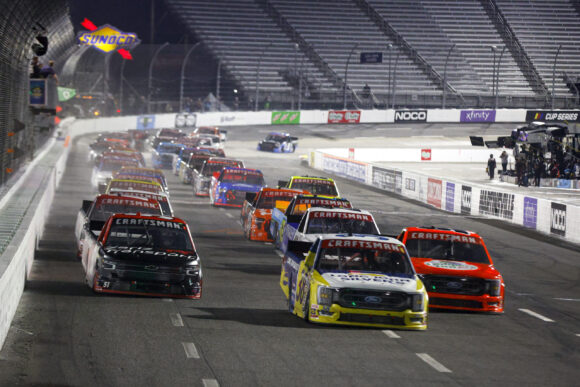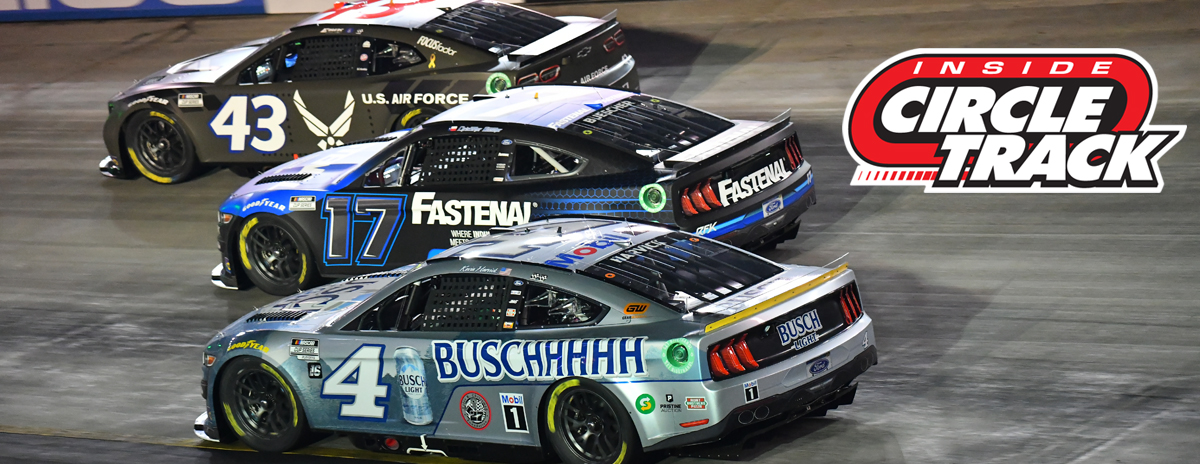
The Truck race in Martinsville began on a damp track(Getty Images)
There was a great deal of ballyhoo made over the fact that NASCAR planned to institute racing in the wet on certain short tracks along with the road courses for the purpose of avoiding delays and postponements. The idea, it has been thought, would give the fans a show rather than having many who cannot stay an extra day or days to watch the running of a rain-delayed event. If Friday night’s Long John Silver’s 200 NASCAR Craftsman Truck Series race is any indication of how that process will work, fans are not going to get very much value for their tickets.
The start of the race had to be delayed, understandably, because of lightning and then a heavy downpour. But it was when the rain stopped that things took a strange and inexplicable turn.
As is usually the case, Air Titans and jet drying trucks were sent onto the half-mile speedway to begin the drying process. As the racing surface began to show signs of improvement, teams were instructed by NASCAR to install their windshield wipers, flashing lights(for visibility), and to bolt on rain tires.
Not long after the above order was given, the track was virtually dry. Still, teams were told to go with the wet tires and that they would not be allowed to change them until a competition caution was called for. The timing of that yellow flag was yet unannounced, so drivers and teams were left guessing.
The competition caution finally came on lap 28. However, pit road was not dry enough to safely have regular type pit stops so, after running numerous laps under caution with machinery trying to improve the pit area, it was decided that the pit stops would be controlled with teams given a certain amount of time to change tires without losing positions.
Two-time NASCAR Cup Series champion Kyle Busch was participating in that race. NASCAR had his crew chief to ask the veteran driver as the trucks circulated around the track before pitting whether teams should get new rain tires or racing slicks. Busch replied, “Slicks, duh.”
A total of 16 laps were wasted under yellow while all of this played out. It didn’t seem like what few fans remained in the grandstand were getting much value.
Stage 1 ended on lap 50 with pit road still too wet to be safe. Instead of just doing another controlled stop, NASCAR then decided to make another attempt at drying pit road so there could be live stops. Lap after lap of riding around under yellow was done and time was wasted as another rain shower crept closer to the track.
The even fewer fans left in the stands and a television audience that had most likely thrown in the towel witnessed an enthralling 20 laps under yellow flag parading. It was almost as if the sanctioning body was waiting for it to rain rather than running enough green flag laps to get the race to the halfway point so that when it invariably rained again it could be brought to a merciful end.
When interviewed by Fox, veteran crew chief Scott Zipadelli summed the night up well. “We don’t seem to know what we’re doing minute to minute right now,” he pointed out.
Later with light rain beginning to fall, racing continued on slick tires until it was finally deemed too wet to continue and the trucks were brought down pit road to be parked.
It was explained that the wet tires are not for racing in the rain, but rather for when the rain had stopped but the track was still wet. Then what’s the point? Especially at the short tracks, the the only places where this will be attempted. The Air Titans can have the track dried quickly.
For something that had been talked about so much, there was a complete lack of planning and/or execution. That race could have been re-set for the next morning on a proper track.
Sports are supposed to be a mixture of competition and entertainment. With its 63 of 124 laps run under caution, this race, ultimately awarded to Corey Heim, had very little competition and virtually no entertainment value.
I will admit my bias here as I have always been and will always be against racing in wet conditions on ovals. Also, anyone who follows my dirt racing coverage likely knows that I do not handle rainouts well at all. But with that said, many claimed last week at Bristol that NASCAR machines are too heavy to race on dirt. If that is true, then they are too heavy to race on a wet track as well. For me, I will wait a day for a race to be run the way it is supposed to be- in the dry.
Please consider also reading:
This Martinsville race has to be better than last spring, right?
Richard Allen has been covering NASCAR and other forms of motorsports since 2008.
Respond to this piece on Twitter –> @RichardAllenIDR
or on Facebook –> InsideCircleTrack/Facebook
